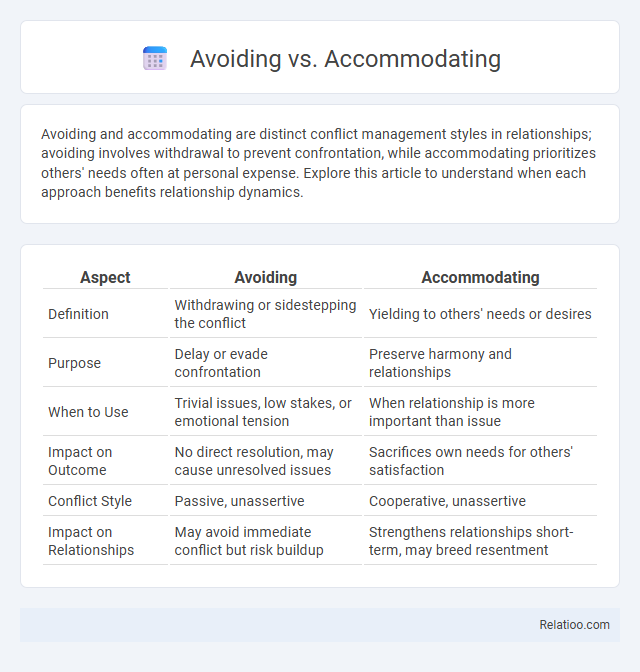Avoiding and accommodating are distinct conflict management styles in relationships; avoiding involves withdrawal to prevent confrontation, while accommodating prioritizes others' needs often at personal expense. Explore this article to understand when each approach benefits relationship dynamics.
Table of Comparison
| Aspect | Avoiding | Accommodating |
|---|---|---|
| Definition | Withdrawing or sidestepping the conflict | Yielding to others' needs or desires |
| Purpose | Delay or evade confrontation | Preserve harmony and relationships |
| When to Use | Trivial issues, low stakes, or emotional tension | When relationship is more important than issue |
| Impact on Outcome | No direct resolution, may cause unresolved issues | Sacrifices own needs for others' satisfaction |
| Conflict Style | Passive, unassertive | Cooperative, unassertive |
| Impact on Relationships | May avoid immediate conflict but risk buildup | Strengthens relationships short-term, may breed resentment |
Understanding Avoiding and Accommodating Conflict Styles
Avoiding and accommodating are two distinct conflict styles with unique impacts on resolution and relationships. Avoiding involves sidestepping the conflict to prevent confrontation, often leading to unresolved issues and increased tension over time. Accommodating entails prioritizing others' needs above one's own, which can preserve harmony but may result in suppressed concerns and imbalance in decision-making power.
Key Differences Between Avoiding and Accommodating
Avoiding involves deliberately steering clear of conflicts to prevent confrontation, often resulting in unresolved issues, while accommodating prioritizes maintaining harmony by yielding to others' needs or demands, sometimes at the expense of one's own interests. The key difference lies in motive and outcome: avoiding seeks to ignore or delay the conflict, whereas accommodating actively resolves it through concession. Understanding these distinctions aids in applying the appropriate conflict management style in interpersonal and organizational settings.
When to Use Avoiding in Conflict Resolution
Avoiding is best used in conflict resolution when the issue is trivial, the potential damage from confrontation outweighs the benefits of resolution, or when emotions are running too high for a productive discussion. It allows time for cooling off and prevents escalation in situations where the conflict is unlikely to affect long-term relationships or goals. Recognizing when to avoid conflicts helps maintain peace and redirects focus toward more critical issues needing immediate attention.
Situations Best Suited for Accommodating
Accommodating is best suited for situations where maintaining harmony and preserving relationships outweigh winning the argument, such as when the issue is more important to the other party or when peace is a priority. It works well when quick resolution is needed, and the accommodator has less at stake or can afford to yield without significant consequences. This style supports long-term collaboration by showing empathy and fostering goodwill, especially in emotionally charged or low-stakes conflicts.
Pros and Cons of the Avoiding Approach
The Avoiding approach in conflict management allows Your team to sidestep confrontation, minimizing immediate stress and preserving short-term harmony but risks unresolved issues escalating over time. It can be advantageous when conflicts are trivial or emotions run high, preventing unnecessary disruption while potentially fostering resentment if problems persist. However, avoiding conflicts limits opportunities for collaboration and shared problem-solving, which may hinder long-term relationship and organizational growth.
Advantages and Disadvantages of Accommodating
Accommodating conflict style emphasizes prioritizing others' needs over your own, fostering harmony and quick resolution during disagreements. This approach benefits relationships by showing empathy and willingness to compromise but can lead to personal dissatisfaction or unresolved issues if your needs are consistently overlooked. Balancing accommodating with assertiveness ensures your interests are acknowledged while maintaining cooperative interactions.
Impact on Relationships and Team Dynamics
Avoiding conflicts can lead to unresolved issues that undermine trust and create tension within your team, decreasing overall collaboration and productivity. Accommodating others' needs often preserves harmony but may result in resentment or unbalanced relationships if your own concerns are consistently overlooked. Recognizing and addressing repeated patterns of avoidance or accommodation helps cultivate healthier team dynamics by encouraging open communication and mutual respect.
Emotional Outcomes: Avoiding vs Accommodating
Avoiding conflict often leads to suppressed emotions and unresolved issues, causing increased stress and resentment over time. Accommodating prioritizes others' needs, fostering short-term harmony but risking emotional neglect and reduced self-esteem in the accommodator. Understanding these emotional outcomes helps individuals choose healthier communication strategies, balancing personal well-being with relationship maintenance.
Practical Tips for Choosing the Right Approach
Avoiding, accommodating, and pattern strategies each serve distinct conflict management roles; avoid non-essential confrontations to save time, accommodate when preserving relationships outweighs the issue, and apply pattern analysis to identify recurring conflicts for long-term solutions. Prioritize situational awareness by assessing issue importance, relationship value, and desired outcomes before selecting an approach. Implement active listening and clear communication to enhance the effectiveness of the chosen conflict resolution method.
Developing Balanced Conflict Management Skills
Developing balanced conflict management skills involves understanding the strengths and limitations of avoiding, accommodating, and pattern approaches to conflict resolution. Avoiding can prevent escalation but risks unresolved issues, while accommodating fosters harmony but may lead to unaddressed personal needs. Recognizing patterns of interaction allows individuals to adapt strategies intentionally, promoting constructive dialogue and sustainable solutions in diverse interpersonal or organizational conflicts.

Infographic: Avoiding vs Accommodating
 relatioo.com
relatioo.com